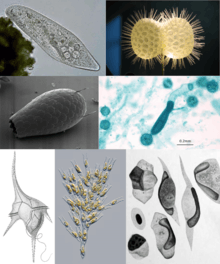SAR supergroup
SAR or Harosa (informally the SAR supergroup) is a clade that includes stramenopiles (heterokonts), alveolates, and Rhizaria.[2][3][4][5] The first letter of each group provides the "SAR" in the name (alternatively spelled "RAS").[6][7]
| SAR | |
|---|---|
 | |
| Scientific classification | |
| (unranked): | Diaphoretickes |
| Clade: | TSAR |
| Clade: | SAR Burki et al., 2007 |
| Clades | |
| |
| Synonyms | |
| |
The term "Harosa" (at the subkingdom level) has also been used for this grouping by Cavalier-Smith (2010).[8] Adl et al. (2012) formalized the SAR supergroup as the node-based taxon Sar. They defined it as:[6]
Sar: the least inclusive clade containing Bigelowiella natans Moestrup & Sengco 2001 (Rhizaria), Tetrahymena thermophila Nanney & McCoy 1976 (Alveolata), and Thalassiosira pseudonana Cleve 1873 (Stramenopiles). This is a node-based definition in which all of the specifiers are extant.
Note that as a formal taxon, "Sar" has only its first letter capitalized, while the earlier abbreviation, SAR, retains all uppercase letters. Both names refer to the same group of organisms, unless further taxonomic revisions deem otherwise. Members of the SAR supergroup were once included under the separate supergroups Chromalveolata (Chromista and Alveolata) and Rhizaria, until phylogenetic studies confirmed that stramenopiles and alveolates diverged with Rhizaria.[9] This apparently excluded haptophytes and cryptomonads, leading Okamoto et al. (2009) to propose the clade Hacrobia to accommodate them.[10]
Phylogeny
Based on a compilation of the following works.[11][12][13][14]
| TSAR |
| ||||||||||||||||||||||||||||||||||||||||||||||||||||||||||||||||||||||||||||||||||||||||||||||||
See also
- Amoebozoa
- Archaeplastida
- Excavata
- Opisthokonta
References
- Parfrey, Laura Wegener; Lahr, Daniel J. G.; Knoll, Andrew H.; Katz, Laura A. (August 16, 2011). "Estimating the timing of early eukaryotic diversification with multigene molecular clocks". Proceedings of the National Academy of Sciences of the United States of America. 108 (33): 13624–13629. Bibcode:2011PNAS..10813624P. doi:10.1073/pnas.1110633108. PMC 3158185. PMID 21810989.
- Archibald JM (January 2009). "The puzzle of plastid evolution". Curr. Biol. 19 (2): R81–8. doi:10.1016/j.cub.2008.11.067. PMID 19174147.
- Burki F, Shalchian-Tabrizi K, Minge M, et al. (2007). Butler G (ed.). "Phylogenomics reshuffles the eukaryotic supergroups". PLoS ONE. 2 (8): e790. Bibcode:2007PLoSO...2..790B. doi:10.1371/journal.pone.0000790. PMC 1949142. PMID 17726520.
- Hampl V, Hug L, Leigh JW, et al. (March 2009). "Phylogenomic analyses support the monophyly of Excavata and resolve relationships among eukaryotic "supergroups"". Proc. Natl. Acad. Sci. U.S.A. 106 (10): 3859–64. Bibcode:2009PNAS..106.3859H. doi:10.1073/pnas.0807880106. PMC 2656170. PMID 19237557.
- Frommolt R, Werner S, Paulsen H, et al. (December 2008). "Ancient recruitment by chromists of green algal genes encoding enzymes for carotenoid biosynthesis". Mol. Biol. Evol. 25 (12): 2653–67. doi:10.1093/molbev/msn206. PMID 18799712.
- Sina M. Adl; Alastair G.B. Simpson; Christopher E. Lane; Julius Lukeš; David Bass; Samuel S. Bowser; Matthew W. Brown; Fabien Burki; Micah Dunthorn; Vladimir Hampl; Aaron Heiss; Mona Hoppenrath; Enrique Lara; Line Le Gall; Denis H. Lynn; Hilary McManus; Edward A.D. Mitchell; Sharon E. Mozley-Stanridge; Laura W. Parfrey; Jan Pawlowski; Sonja Rueckert; Laura Shadwick; Conrad L. Schoch; Alexey Smirnov & Frederick W. Spiegel (2012). "The Revised Classification of Eukaryotes". Journal of Eukaryotic Microbiology. 59 (5): 429–493. doi:10.1111/j.1550-7408.2012.00644.x. PMC 3483872. PMID 23020233.
- Sandra L. Baldauf (2008). "An overview of the phylogeny and diversity of eukaryotes" (PDF). Journal of Systematics and Evolution. 46 (3): 263–273. doi:10.3724/SP.J.1002.2008.08060 (inactive 2020-01-17).
- T. Cavalier-Smith (June 2010). "Kingdoms Protozoa and Chromista and the eozoan root of the eukaryotic tree". Biol. Lett. 6 (3): 342–5. doi:10.1098/rsbl.2009.0948. PMC 2880060. PMID 20031978.
- Dawkins, Richard; Wong, Yan (2016). Ancestor's Tale. pp. 573–577. ISBN 978-0544859937.
- Fabien Burki (2014). "The eukaryotic tree of life from a global phylogenomic perspective". Cold Spring Harbor Perspectives in Biology. 6 (5): 1–17. doi:10.1101/cshperspect.a016147. PMC 3996474. PMID 24789819.
- Ruggiero; et al. (2015), "Higher Level Classification of All Living Organisms", PLoS ONE, 10 (4): e0119248, Bibcode:2015PLoSO..1019248R, doi:10.1371/journal.pone.0119248, PMC 4418965, PMID 25923521
- Silar, Philippe (2016), "Protistes Eucaryotes: Origine, Evolution et Biologie des Microbes Eucaryotes", HAL Archives-ouvertes: 1–462
- Cavalier-Smith, Thomas (5 September 2017). "Kingdom Chromista and its eight phyla: a new synthesis emphasising periplastid protein targeting, cytoskeletal and periplastid evolution, and ancient divergences". Protoplasma. 255 (1): 297–357. doi:10.1007/s00709-017-1147-3. PMC 5756292. PMID 28875267.
- Strassert, Jürgen F. H.; Jamy, Mahwash; Mylnikov, Alexander P.; Tikhonenkov, Denis V.; Burki, Fabien (2018-08-30). "New phylogenomic analysis of the enigmatic phylum Telonemia further resolves the eukaryote tree of life". Molecular Biology and Evolution. 36 (4): 757–765. doi:10.1093/molbev/msz012. PMC 6844682. PMID 30668767.